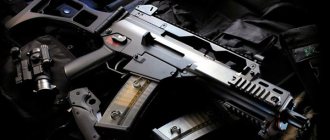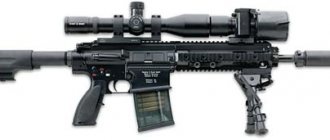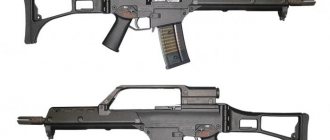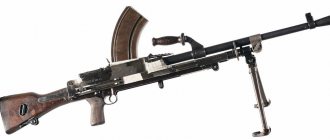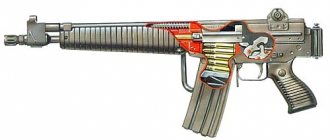History[edit]
In the early 1970s, Heckler & Koch created the shortened HK 53 assault rifle, which began production in 1975. The HK 53 assault rifle was developed as a weapon for use as a “heavier” alternative to submachine guns, as are most assault rifles of this class (AKM-74U, SIG SG 552 Commando, etc.).
The HK 53 caliber 5.56×45 mm (.223 Rem) is developed on the basis of the HK 33 assault rifle previously released by Heckler & Koch (which in turn was created on the basis of the HK G3) and differs from its predecessor only in smaller size and weight and combines It has the power of an assault rifle with the compact dimensions of a submachine gun.
The shortened HK 53 assault rifle was adopted by special forces around the world, in particular the German GSG-9, British SAS and American SWAT.
The HK 53 assault rifle did not become particularly widespread, and later gradually began to be replaced by the shortened HK G36 assault rifle produced by the same company Heckler & Koch.
Engine AJ-26/NK-33: “two-faced Janus” that destroyed Antares?
To call what happened at the Wallops Space Center in Virginia a disaster would be a bit of an understatement: the $200 million Antares launch vehicle, designed and built by US company Orbital Sciences, crashed 12 seconds after liftoff.
Well, it happens. A rocket is a delicate, capricious technology and can fail, especially at the beginning of its flight life. “Antares” is a new car, and it cannot be said that it was a “difficult teenager” from birth. From April 2013 to July 2014, Antares left the atmosphere four times without problems.
During three of these missions, Antares carried the Cygnus automated transport vehicle under its fairing to the ISS. Twice “Cygnus” delivered the necessary cargo to the station. This is the most important task assigned to him by NASA.
The agency entered into a $1.9 billion contract with Orbital Sciences, under which the company must deliver 20 tons of cargo to the ISS through 2016 inclusive, using eight of its transport ships. Therefore, the Antares accident caused a headache not only for Orbital Sciences, but for the American aerospace agency, which will now have to think about when and what to carry food, water, equipment for experiments, etc. to its astronauts.
However, maybe the results of the investigation will show that at Antares they simply “didn’t tighten the nut” somewhere. It’s a shame, of course, but at the same time it’s a reason to breathe a sigh of relief - next time you’ll need to be more careful in assembling the rocket, and there won’t be any problems. At the very least, David Thompson, head of Orbital Sciences, believes that experts will identify the range of possible failures within a few days, although it may still be some time before the main cause of the accident is finally established.
But what if it’s not the “nut”? What if the fall of Antares was the result of a design flaw in the rocket or its low reliability? Video footage showed that the failure occurred in the first stage. This part of the rocket has three “parents”: Orbital Sciences itself, the Russian SNTK named after. N. D. Kuznetsova (Samara Scientific and Technical Complex named after Nikolai Kuznetsov) and the Ukrainian Yuzhnoye Design Bureau.
So, through the fault of which of these three parents did their “child” die? Let's start with the one who was the first to be pointed at. As you might guess, this is Russia.
The Ballad of the Lunar Engine
Here is what is written in the American “Operating Manual” for the Antares launch vehicle: “The first stage of Antares uses two AJ-26 engines. "Aerojet has upgraded the avionics and control systems of these engines."
What does Russia have to do with it? We read further: “The two Aerojet AJ-26 engines are Russian modified NK-33 engines, originally developed for the Russian N-1 rocket [the launch vehicle that was supposed to carry Soviet cosmonauts to the Moon in the late 1960s - Yu.K. .]… These engines are in working order, they have good technical characteristics and they have undergone a serious testing program.”
Thus, the Soviet-Russian engine unwittingly became a “two-faced Janus”, one face of which is the NK-33, and the other is the AJ-26.
NK-33 did not end up in the United States “suddenly.” According to the vice president of Orbital Sciences, former astronaut Frank Culbertson, in an interview with the Washington Post, “there are not many engines in the world” that would have the size-to-weight ratio of the engine required for Antares. , and its traction. “Unfortunately, there was definitely no such engine in the USA,” he added sadly.
Wipe with a cloth and renew
NK-33 engines were shipped to the USA from a warehouse where they had been collecting dust for more than 40 years. Age is age, even for iron. “When we tested the engines, we found signs of age-related fatigue, including cracks,” Culbertson said. “We carried out a thorough inspection of them and tweaked them here and there.”
In addition, as the Manual states, “each AJ-26 engine was equipped with modern components and underwent fire testing at the Stennis Space Center before being installed on the carrier.”
There is, however, one fly in the ointment: in May of this year, during testing at the Stennis Center, one AJ-26 failed. But after this, fire tests of the modernized NK-33 were carried out in August in Russia. Representatives of Aerojet Rocketdyne were also present at the tests. The engine ran successfully, there were no comments.
But testing is one thing, but real flight is still another. So, did the NK-33 “go wrong”? Let's not rush to conclusions. Let's see what else is written in the mentioned “Operation Manual”.
"Zenith" and "Antares": common genetics
According to this document, “Basic elements of the first stage, including fuel systems, are manufactured by the state enterprise Yuzhmash under the control of the Yuzhnoye Design Bureau.” Both are located in Ukraine.”
“Although the Antares first stage systems were specifically designed for this launch vehicle,” the manual states, “they are essentially a development of the design and systems of the Zenit series of launch vehicles, which have a long operating history , which includes more than 60 successful launches."
Does “more efficient” always mean “more reliable”?
The creators of Antares, including Orbital Sciences and Aerojet Rocketdyne, have repeatedly emphasized that they have “significantly modernized” both the NK-33 and the Zenit systems. But does this mean that this engine and systems have become more reliable?
In this regard, one involuntarily recalls the Soviet An-32 transport aircraft. It grew out of the An-26 aircraft, which was largely similar to it. Designers, in order not to make the production of a new car too complicated and expensive, took the path of least resistance. They took the An-26 airframe and installed more powerful engines on it.
At first glance, the idea was not bad, if not for one “but”: the more powerful engines literally turned out of the wings of the An-32, which were not designed for such thrust. You shouldn’t imagine blood-curdling pictures of engines being torn off from the wings - thank God, it didn’t come to that. Regular technical inspection of the An-32 made it possible to timely identify fatigue cracks appearing in the wings and in the area where the engines were installed and either send such aircraft for major repairs or write them off altogether.
But unlike an airplane, a disposable launch vehicle engine, designed to the limit, has a smaller margin of “survivability,” and therefore off-design loads can have much more catastrophic consequences for it than for winged vehicles.
What's next?
NASA representatives have already stated that Cygnus’s “under-flight” to the ISS will not create any problems for the crew, who have enough supplies of everything they need to easily wait for the arrival of the next ship. Perhaps, as was already noted at the beginning, we are talking about a minor manufacturing defect that can be easily eliminated, and the remaining Antares with Russian-American AJ-26/NK-33 will safely continue to launch transport ships with cargo for the ISS into space. Although, according to Thompson, the next launch of Antares, scheduled for April 2015, will apparently be delayed by three months, but in any case - no more than a year.
Many American newspapers are now recalling what the head of SpaceX, Elon Musk, said last year (remember that this company also has a contract with NASA to deliver cargo to the ISS). According to Musk, using Russian engines developed in the 1960s “was pretty stupid.” Moreover, not just developed, Musk clarified, but manufactured during that period of time and “stored somewhere in Siberia.”
For reference: Orbital Sciences, unlike, for example, the American United Space Alliance (ULA), which had no intention of abandoning the Russian RD-180 for its Atlas-5 carrier, did not at all plan to constantly use the NK-33, even in the form AJ-26. All Russian engines that Orbital Sciences needed have already been sent to the United States. There will be no more deliveries.
According to Thompson, his company intends to abandon the AJ-26 over the next two years, since on the one hand their use “is associated with serious technical problems,” and on the other hand, engines and spare parts for them are quite difficult to transport from Russia. The Antares accident, Thompson emphasized, will speed up the implementation of these plans. The launch vehicle will use American-made engines, although it is not yet entirely clear which ones.
Through the Magnifying Glass of Politics
Alas, the deterioration of Russian-American relations, threats from Russia to leave America either without the RD-180 or without the Soyuz, as well as the recent proposal of the government that was included in the sanctions list to “limit international cooperation in the use of Russian ISS modules” do not contribute to the sympathy of either American politicians, not representatives of the US space industry, to the idea of continuing cooperation with Russia in space. Many therefore involuntarily see the root of the evil that led to the Antares accident in the NK-33 engine.
However, Culbertson, who analyzed video footage of the unsuccessful launch, came to the conclusion that the first stage began to “disassemble itself” as it climbed. It is possible that problems have arisen with the structural strength of the carrier, and if this is confirmed, then those who designed and assembled it will have to answer for this - that is, Orbital Sciences and Yuzhmash.
We will not rush to make accusations until the results of the investigation are completed. But, alas, one thing is clear - this accident again involuntarily drew attention to the archaic nature of Russian space technology, and shook another support under the already shaky bridge of Russian-American cooperation in space.
According to leading American space policy expert John Logsdon, expressed in an interview with Voice of America, even if there is a serious delay with subsequent Antares flights, the United States is unlikely to ask Russia to sell them Progress to deliver cargo to the ISS. The political climate is not the same.
Rather, NASA will enter into a contract with SpaceX for additional cargo missions to the ISS, or, as a last resort, will send a prototype of the Orion manned spacecraft to the station in a cargo version. Let us remind you that Orion is scheduled to make its first test flight in December of this year.
Construction[edit]
The HK 53 assault rifle is a variant of the HK 33KA3 with an even shorter barrel, without differing from it in design. Like the HK 33, the HK 53 is based on the semi-blowback principle, slowed down by a pair of rollers. This system is successfully used on all machines in this series, starting with the HK G3 machine.
The trigger mechanism is hammer-operated, integral with the pistol grip and trigger guard in a separate housing, and folds down when disassembled incompletely. The trigger allows for 3 fire modes: single, automatic and with a three-round cut-off. The fire selector is combined with a safety, located on the left side above the pistol grip and has 4 positions. On early models, there was no possibility of firing 3 rounds; the safety switch had 3 positions, respectively. The HK 53 receiver is stamped.
An elongated four-slit flash suppressor is mounted on the muzzle of the barrel, which effectively reduces the muzzle flame caused by incomplete combustion of gunpowder in a short barrel. The sighting devices consist of a front sight and a drum rear sight in the same way as on the HK 33. At the same time, proprietary quick-release mounts for optical or night sights can be installed on the HK 53 series assault rifles, which do not require modification of the weapon or re-shooting after removing and reinstalling the sight.
Initially, the HK 53 assault rifles, as well as the HK 33, were equipped with magazines with a capacity of 25 or 40 rounds. They were later used with 25- or 30-round magazines, but the 40-round magazines were discontinued. The plastic handguard is identical in design to the handguard of the HK MP5 submachine gun.
On the HK 53, unlike the HK 33, it is impossible to install a bayonet and an under-barrel grenade launcher.
Assault rifle (automatic) Heckler & Koch series HK 33
| HK 33A2 |
In the second half of the 1960s, the German company Heckler & Koch created a new assault rifle (machine gun) HK 33, production of which began in 1968.
The HK 33 rifle, caliber 5.56x45 mm (.223 Rem), is developed on the basis of the G3 assault rifle, caliber 7.62x51 mm (.308 Win), previously released by Heckler & Koch and differs from its predecessor in its smaller caliber, size and weight.
In essence, the HK 33 is a modification of the HK G3 with a reduced caliber. The reduction in caliber did not entail any changes in the design of the machine gun. Like the HK G3, the HK 33 assault rifle is based on the principle of automatic semi-blowback action, slowed down by a pair of rollers.
| HK 33A3 |
The HK 33 series assault rifles are available in several modifications:
| HK 33A2 | HK 33A3 | HK 33KA3 | |
| Caliber, mm | 5.56x45 (.223 Rem) | ||
| Length, mm | 920 | 940 / 735 | 865 / 675 |
| Barrel length, mm | 390 | 390 | 322 |
| Weight, kg | 3.65 | 3.98 | 3.89 |
| Store, count. cartridges | 25, 30, 40 | ||
| Initial bullet speed, m/s | 950 | ||
| Effective firing range, m | 100 — 400 | ||
| Rate of fire, rds/min | 750 | ||
— HK 33A2 – standard basic version with a fixed stock and trigger with the ability to fire automatically. — HK 33A3 – standard version with a telescopic butt. — HK 33KA3 – carbine, the shortest version of the entire HK 33 family with a barrel length of 322 mm and a telescopic butt. — HK 33EA2 – version with a trigger with the ability to fire with a cutoff of 3 shots. The stock is fixed. The letter “E” in the abbreviation of all modifications means “export”. — HK 33EA3 – version of HK 33EA2 with a telescopic butt. — HK 33EKA3 – a variant of the HK 33KA3 with the ability to fire with a cut-off of 3 shots.
The HK33 family of assault rifles (machine guns) is built according to an automatic scheme with a semi-free bolt, the opening of which is slowed down using a pair of rollers. To ensure normal extraction, longitudinal grooves are made in the walls of the chamber, ensuring equalization of gas pressure outside and inside the cartridge case to prevent it from swelling during early extraction, typical of semi-blowback schemes.
A replaceable trigger mechanism module assembled with a pistol grip and trigger guard is attached to the stamped receiver. Depending on the configuration, it is possible to install various trigger options, including those with or without the ability to fire in bursts of 3 shots.
HK 33KA3
The assault rifle uses traditional sighting devices for Heckler & Koch weapons - a front sight and a drum rear sight, graduated from 100 to 500 meters in range. If necessary, all HK33 series assault rifles can be equipped with proprietary quick-release mounts for optical or night sights, which do not require modification of the weapon or re-shooting after removing and reinstalling the sight.
Initially, the NK 33 series assault rifles were equipped with magazines with a capacity of 25 or 40 rounds. They were later used with 25- or 30-round magazines, but the 40-round magazines were discontinued.
The stock can be fixed made of plastic (models with index A2) or retractable made of metal with a rubber butt pad (modifications with index A3).
| HK 33EA2 with mounted grenade launcher |
Full-size HK33 assault rifles can be equipped with a 40 mm grenade launcher and a bayonet. In addition, it is possible to fire rifle grenades from the barrel of the rifles.
HK 33EKA3
HK 33KA3 carbines have a shortened barrel, without the ability to fire rifle grenades and install a 40-mm grenade launcher, and otherwise do not differ from the base model.
The HK 33 was developed as a commercial weapon for export and therefore did not enter service with the German army, but was adopted by some German police units and security services.
The HK 33 assault rifle in various versions has been adopted in more than 20 countries and is widely exported, including to the USA.
For the civilian market, the production of the HK 93 semi-automatic rifle, which is an analogue of the HK 33A2 assault rifle, was launched.
| HK 93 with 40 round magazine |
In the 1970s, based on the HK 33 assault rifle, the shortened HK 53 assault rifle and the HK 13 light machine gun were developed.
Since 1999, NK 33 has been produced under license in Turkey and entered service with the Turkish Army.
Operating countries[edit]
Select a country or scroll your mouse wheel
- Great Britain - in service with the Royal Military Police and SAS in Northern Ireland, as well as the Cumbrian constables.
- Hong Kong - into service with the special duty unit "Flying Tigers".
- Indonesia - adopted by KOPASKA and KOPASSUS. Free Aceh
